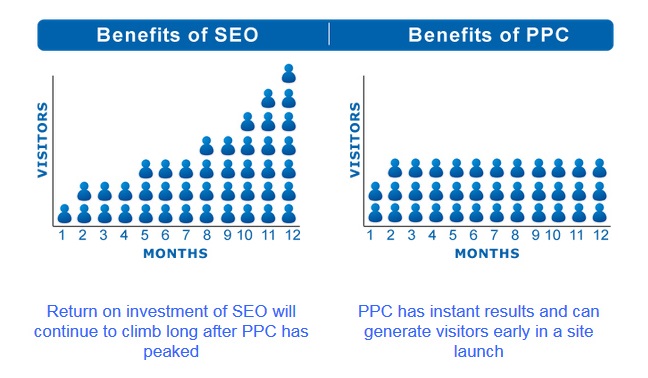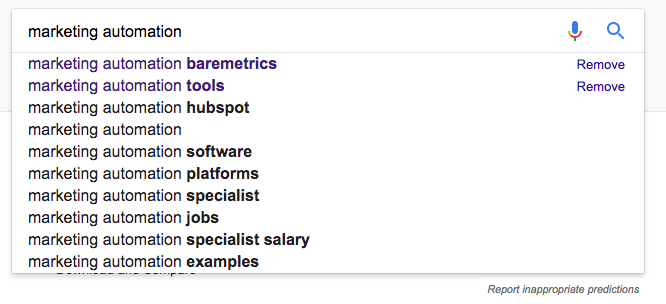Speaking with business owners, I often hear the same thing:
“SEO has become ineffective – it’s too competitive, the noise-to-value ratio is too high. It’s become almost impossible to generate high-quality B2B leads through content.”
None of that is true.
While it has certainly become more challenging to succeed with SEO in recent years, smart marketers know that there are ways to make a mark with content.
Moreover, because the benefits of SEO accrue over time, it’s one of the few strategies that become more effective over time.
With tactics like paid search you need to keep spending money to continue driving leads and sales. Whereas, with SEO, the resources you put in add up over time ensuring a great ROI.
As time passes and you produce more content, attract more links to your content, and rank for more and better keywords, you start getting more organic traffic.

For any B2B company, SEO is one of the few sustainable ways to create an audience, generate leads, and, ultimately, close customers. More than 70 percent of B2B researchers admit that they start their buying process with a generic search.
However, to succeed with SEO, you need to put resources into it. That includes:
- Producing great content.
- Doing outreach.
- Building links.
All of these require investing time, human power, and often even a separate budget.
The upside of this is that it’s helping you create and preserve an advantage over your competitors that don’t have the resources to put into this effort.
Writing a research-backed 6,000-word guide on conversion rate optimization best strategies is hard and time-consuming, but that’s what will make your guide noticeable in a sea of 500-word-long blog posts that regurgitate the same old advice.
So how do you balance between the need to produce content that’s hard to replicate and the resources that requires? Use a process that is repeatable and scalable.
This article will show you how to effectively employ SEO to generate high-quality B2B leads, by sharing a framework you can apply for your business.
1. Keyword Research: Target Topic Clusters, Not Single Terms
Keyword research is the core of a successful SEO strategy no matter whether you’re just getting started with a new website, redesigning an existing one, or just looking to update your content.
When planning your strategy, it’s important to understand how keywords work today.
It is no longer necessary to produce separate pieces of content that target similar keywords.
Most search engines now have strong understanding of how keywords relate to each other. That means you can create one exhaustive piece of content to target “adjacent” terms such as:
- Social media marketing tools
- Tools for social media marketing
- Managing a social media marketing campaign
- SMM tools, etc.
There are multiple resources on how to come up with good keywords, but a good brainstorming session is usually the best starting point. Take some time to write down some of the most popular ways in which you (or your customers) describe your product/service.
Don’t spend too much time trying to come up with an extensive list.
The most effective approach is to talk to your existing customers. It’s essential to develop a good ear for what customers are saying and how they’re talking about the topics you’re interested in. This will help you broaden your list of keywords and find relevant terms that can help you drive even more customers.
Social networks such as Quora, LinkedIn, Reddit, and maybe even Facebook groups (depending on the industry you’re in) are all suitable places to deepen your understanding.
Keep an eye on the discussions and the topics that are relevant to your business and make sure that you understand what your audience is talking about and how they’re talking about it.
Google Autocomplete can also help you expand your list of keywords. Start by typing a general term that is relevant to your business. Instead of hitting Enter to see the results, review the suggestions that come up:
Write down those that seem relevant and promising. In this example, if I’m selling marketing automation software, terms like “tools,” “software,” and “platforms” should definitely be included in my list.
Another way to find suggestions inside Google is by looking at the related searches section at the bottom of SERP:
Finally, conducting professional keyword research with a specialized tool, such as Ahrefs or SEMrush, is another effective way to identify terms for your SEO strategy.
Understanding Keyword Intent is Key
On top of understanding how different terms are connected, search engines are getting exceedingly better at understanding the intent behind each search. That means it’s crucial for you to understand this intent as well and address it with the content you create.
The first step is just to plug the keyword into Google and review the results on the first 1-2 pages. If you see a lot of “how-to” guides and similar informational pages, you will know that the intent of searchers is to learn more about this topic. If, on the other hand, you see a large number of product pages, then you can safely assume that the people who search for this have a high commercial intent.
For example, there’s obviously strong commercial intent behind a term like “buy marketing automation software.” On the other hand, a search for “how to get started with marketing automation” will probably yield a completely different set of results.
You should use the findings of this research to create a map of your content and decide what type of collateral you need to produce for each keyword.
For instance, you’ll want to rank for informational terms with blog posts, white papers, etc., and target keywords with high commercial intent with product/landing pages that are focused on closing a sale.
Prioritizing Keywords
Your keyword research will probably produce an extensive list of potential ranking terms. Therefore, you must know how to prioritize your resources for maximum effect.
The key to this step is to find a good mix between search volume and difficulty. Some keywords get high search volume, but that also means there are many websites that are targeting them, making it difficult to appear on the first page.
Make sure you check out how competitive a keyword is before you invest time in creating content and trying to rank for it. In some cases, when a search term is overtly competitive, it’s better to go for another keyword that has a lower search volume, but would also be easier to rank for.
2. Creating Content: From Blogging to Hub & Spoke Content
High-quality content is one of the most important factors for the success of your SEO strategy.
However, publishing a large number of unrelated blog posts – even if they’re very well written – isn’t going to work. That’s why we see more and more brands organize their content around a hub and spoke model (i.e., hub pages) that contains links to all relevant content on the topic (the “spokes”).
This strategy is great for ranking for highly competitive keywords – it combines high-quality content, strong on-page optimization and internal linking, and sends strong signals to Google in the form of higher time on site and pages per visit (since visitors need to click away from the hub page to find the information they’re interested in).
The most important thing when creating content is to give it some form of competitive advantage – something that distinguishes it from other resources on the topic and isn’t easy to replicate.
How can you do this? Here are a few ideas:
- Using relevant and recent data (especially good tactic if the data is proprietary or there’s limited access to it.)
- Talk to industry leaders and present their opinion in your content.
- Ak an expert practitioner share their know-how (e.g., you could ask an SEO professional to explain step-by-step how they perform a website audit.
Investing time in producing high-quality content is important, but not enough.
You also need to put the same effort in promoting your posts and pages and getting other websites to link to them. Recent research has found that links are still the most important factor when it comes to influencing Google rankings.
3. Content Upgrades: Make It Part of Your ABM Strategy
As you start publishing more content, you’ll find that there are specific topics that drive traffic to your site, but the people who visit are not quite ready to become customers yet. This type of informational content is perfect for generating leads.
Your focus at this point should be on:
- Driving occasional visitors to subscribe to your email list.
- Building up relationships with your visitors.
- Earning their trust.
To convert visitors into leads, you can produce additional collateral that builds upon the topics discussed in your most popular blog posts. These so-called “content upgrades” can take the form of downloadable whitepapers, checklists, or anything similar. The goal is to get visitors to share their email address with you to start building a relationship.
Producing the one-size-fits-all content upgrades we’re accustomed to is pointless.
With more companies switching to account-based marketing (ABM), B2B marketers also need to adjust their approach toward producing these assets. In ABM marketers are approaching a much smaller (and higher-value) group of target accounts. Because of that, they can (and have to) spend longer to understand the needs of the people behind each account and produce content assets that are highly personalized.
At this point, most companies start nurturing their leads by sending them highly targeted email campaigns looking to educate and engage before asking for a sale.
Email certainly isn’t the only channel where such campaigns can exist. Companies like Drift have started experimenting with removing all lead forms, making their content freely accessible. They use analytics and chatbots to identify their most committed readers and turn them into leads.
SEO Is the Best Channel for B2B
Although SEO is becoming increasingly challenging and noisy, there’s still a clear-cut path for B2B brands that want to use it to attract new customers. That path goes through following three main steps:
- Take the time to learn about the people in your audience.
- Create content that answers the questions they have in a better way than anything existing.
- Give them even more value in the form of a downloadable document, get their email in exchange for it, and turn them into leads.
The reason this strategy (still) works is that it’s built on caring about your customers. When you invest the time to learn about their needs and give them something that can help them overcome those challenges, they will reward you with their sincere affection and loyalty.
More SEO Resources Here:
- 5 Things Every SEO Strategy Needs
- The Most Important Aspect of SEO
- How to Combine SEO & Content for Bigger Wins
Image Credits
In-Post Photo #1: SEOPressor
Screenshots by Alexander Kesler. Taken December 2017.







![[SEO, PPC & Attribution] Unlocking The Power Of Offline Marketing In A Digital World](https://www.searchenginejournal.com/wp-content/uploads/2025/03/sidebar1x-534.png)